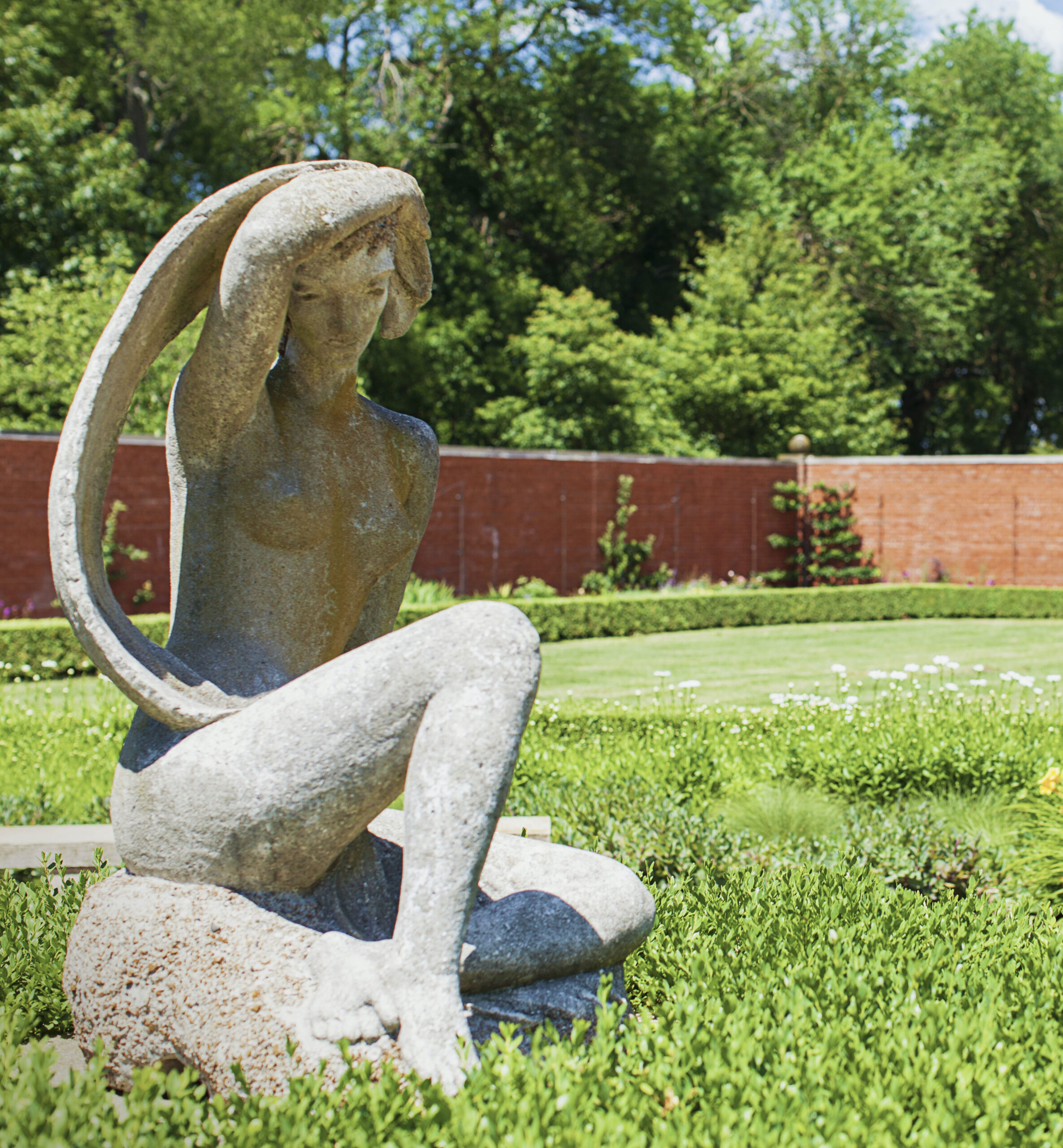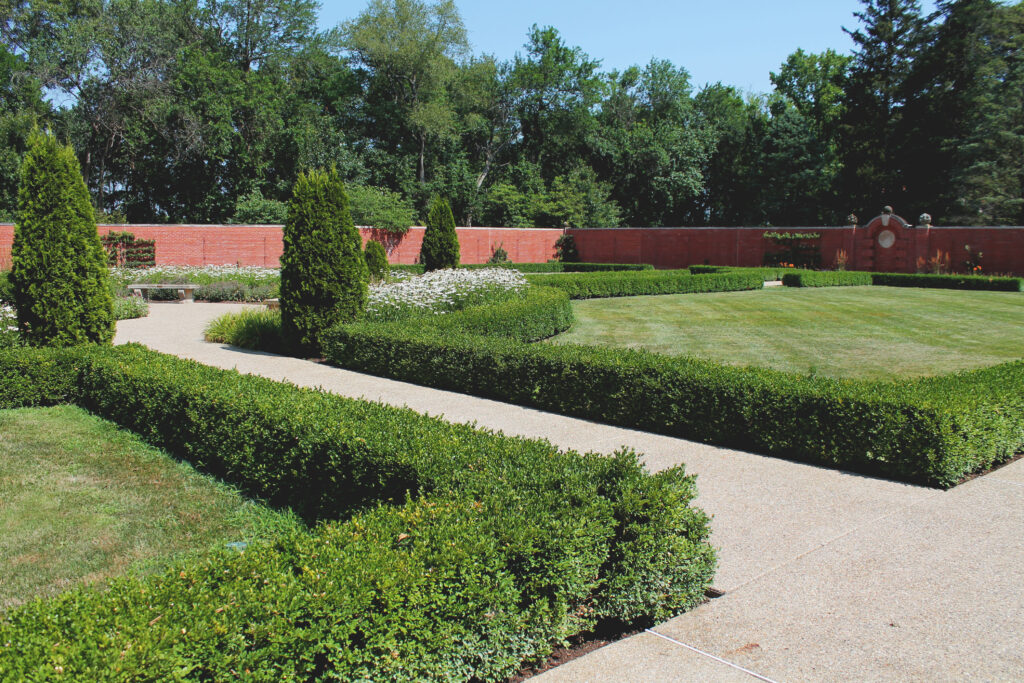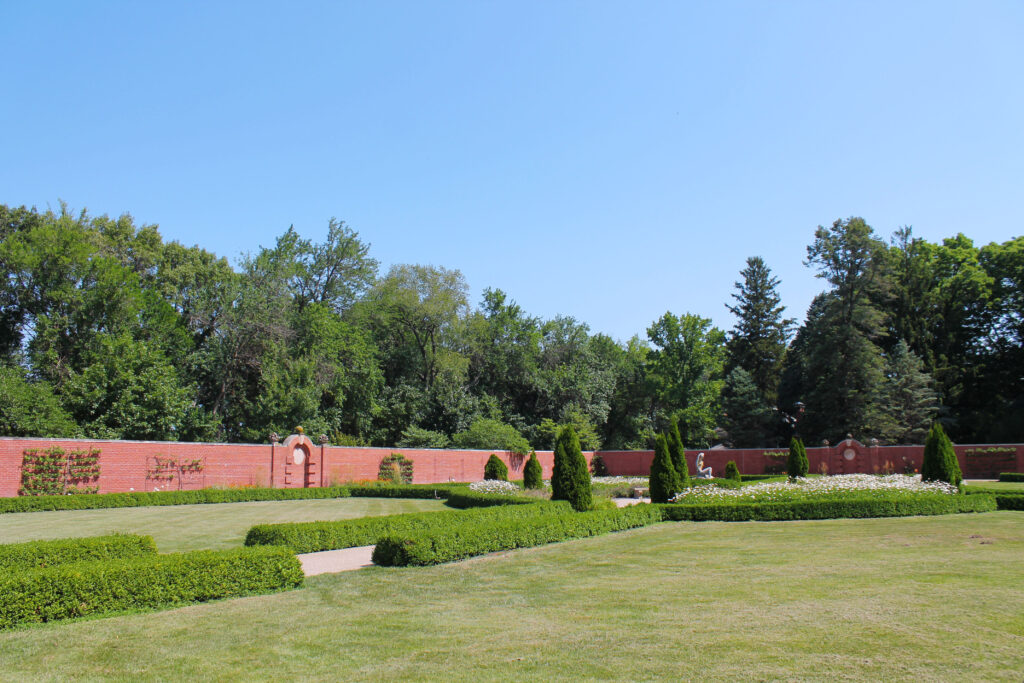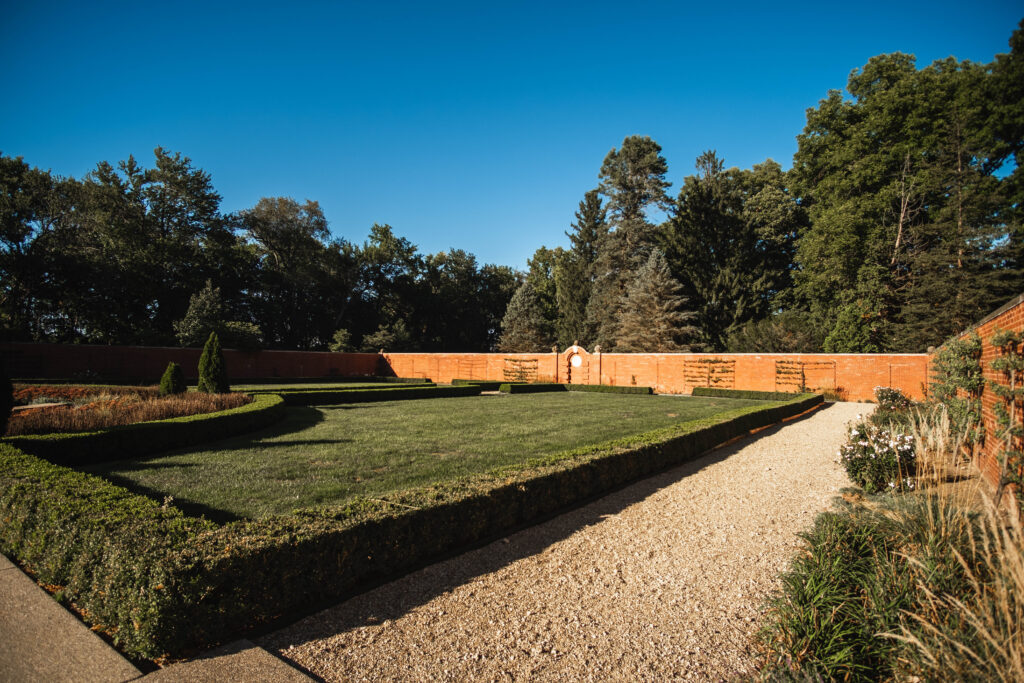The Brick Wall Garden, designed by architect John Borie, is the oldest of the Formal Gardens. In keeping with the Western European tradition, it was a vegetable garden meant to supply the occupants of the house with fresh produce. Fruit trees were trained to grow against the wall – espalier fashion – using warmth from the enclosed walls to ripen the fruit. By the 1920s, flowers, trees, and vines filled the spots where carrots and other such vegetables staples had been planted. In the 1940s, Allerton replaced the vegetables with grass.
Gates and niches designed by Borie were originally placed at the entrances and terminal views. Eight years later, Borie modified the east entrance to be an alcove with stone fruit baskets topping the area. The original iron gates, with the letter “A” for “Allerton”, can now be seen near the Chinese Maze Garden.
A dipping pool eight feet in diameter was originally built in the center of the garden for the gardeners to cool themselves on hot summer days. But in 1933, Robert had it removed to make way for Girl with a Scarf, the last piece he bought for his Illinois estate. He obtained the sculpture through the Art Institute of Chicago’s 1941-42 Exhibition of American Paintings and Sculpture.
Today, the Brick Wall Garden contains lawns, bulbs, and annual and perennial flowers. Espalier apple trees growing against the walls, now maintained for looks instead of fruit production, still take careful training and pruning by our dedicated volunteers. Perennial borders line each of the four walls bringing color and variety to the garden. Turf lawns are meticulously maintained by Allerton’s full time horticulture staff on a strict schedule of over seeding, fertilizing, core aeration, and irrigation. ‘Green velvet’ Boxwood hedges anchor the four square garden, replacing where Robert Allerton once had Privet, an invasive and high-maintenance hedge. The four turf spaces provide an excellent carpet for wedding ceremony guests, and bulbs and annuals in the center planting bed provide an ever-changing scene for Park visitors to enjoy year after year.
ART
 Girl with Scarf (1942)
Girl with Scarf (1942)
Artist Lili Auer (1904-?) created this modeled concrete figure. The sculpture stands at 4’ high.
Robert Allerton bought Lili Auer’s Girl with a Scarf at the Chicago Art Institute’s annual Exhibition of American Painting and Sculpture, 1941-42, and had a special place prepared for it in the center of the Brick Garden. It was the last piece he acquired for the estate.
An agreeable addition conforming in every way to the aesthetic that Allerton established early in his years of collecting outdoor sculpture, it is graceful and unobtrusive-a rather dreamy sunbather leaning back on a coarse, peagravel-embedded rock, letting a scarf arc round her slim nude body and through her legs. The smooth white silica sand surface of the figure is alive with brightness when sunshine plays on it.
Instead of modeling the work first in plaster or clay as was customary, Auer used an uncommon and difficult technique, first creating the framework for the hollow figure with iron bars and wire mesh (the armature) and then roughly troweling over it a relatively dry mixture composed of cement, fine and coarse crushed rock (aggregate), and water. Care had to be taken to keep the armature from breaking through the surface, or even from being close to the surface, as the iron oxide tends to leach through and stain the sculpture’s original clean, clear appearance. Currently, the sculpture is weakened by cracks, and black lichen discolors the surface.
Auer studied at the Woodcarving Trade School and the Academy of Fine Art, Munich, from 1920 to 1930 and exhibited at the Art Institute of Chicago ten times between 1933 and 1945.
Sea Maidens (1930) By Richard Kuöhl (1880-1961). The two bronze figures stand at 6’ high.
By Richard Kuöhl (1880-1961). The two bronze figures stand at 6’ high.
The placement of Kuöhl’s darkly patinated bronze figures at either side of a gravel pathway leading to the Brick Wall Garden nicely relates them to the meditative Girl with a Scarf just beyond. In Art Deco style, they are mounted frontally on John Allerton’s tall white fluted square columns.
Robert Allerton commissioned the statues after seeing a similar figure done by Kuöhl in Hamburg to advertise the Hamburg-American Line, a passenger-ship company. That figure stood atop a kiosk and held a Viking longboat, but Allerton had the artist change the accessory to a bowl of plenty, more in keeping with the spirit of the sculptures’ midwestern prairie destination. At first the patron thought also of having a pair, male and female, and asked the artist to work up a masculine counterpart to the kiosk woman. But, John Allerton recalled, his father turned down the proposed mate as “too static and without the grace and charm of the female.”
Mirror images of each other, the maidens’ lithe, pubescent bodies show under transparent drapery, their watery origins suggested by seaweed-embossed embroidery and ropey seaweed garlands.
John Allerton wondered whether the male was ever made, and described other Kuöhl work: “We have here [in Hawaii] two small figures cast in ‘clinker,’ which is red terra cotta really. They were left over from a building in Hamburg called Chile Haus. l also have two bronzes of a mermaid riding a fish, also ‘right and left’ figures. Oh yes, and still more, ones he had done for a bank and were part of four window grilles. No wonder Kuöhl never became famous because we have so many of his creations hidden away.”
Terminal Busts, before 1900
These two marble statues are copies of late Renaissance models. They stand at 6’6” high.
Two odd marble statues-partially draped, truncated, demure armless female nudes on decorated, tapered shafts stand against the Library Terrace brick walls. Renaissance-type figures such as these are sometimes adapted by architects for purely decorative purposes, but they were used in antiquity as pillars to mark boundaries. Garden books refer to them as “herms,” for male and female heads or figures of the Hermes type; as “caryatids,” even if they do not bear structural blocks or vases on their heads; or “terms,” standing for terminal busts or figures on four-sided columns. John Allerton described them as terminal busts, “a rather poor name,” he added, “but it’s the official title.” In a 1952 memo, Par Danforth, the Park’s first director, attested that Robert Allerton purchased the pieces “in an antique shop in Rome some fifty years ago. They either came from the Pope’s Villa or are copies of those at the Pope’s Villa.”
< Back to all Gardens.






